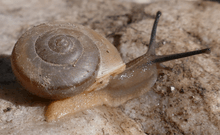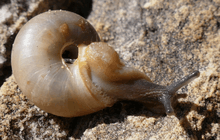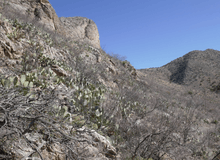Sonorella neglecta
Sonorella neglecta is a terrestrial pulmonate gastropod mollusk in the family Helminthoglyptidae. Sonorella is a genus of large land snails consisting of over 80 species, with new ones continuing to be described.[2][3] The shells typically differ only rather subtly, but proportions of the genitalia differentiate species. The genus is distributed in the southwestern USA (Arizona, New Mexico and NW Texas) and northern Mexico, with individual species often restricted to a single mountain massif ("sky island") or to a small part of one.[4][3] Sonorella neglecta is such a narrow-range endemic from the Chiricahua Mountains. Its official vernacular name is the Portal Talussnail.[5]
| Sonorella neglecta | |
|---|---|
 | |
 | |
| Adults at type locality | |
Not evaluated (IUCN 2.3) | |
| Scientific classification | |
| Kingdom: | |
| Phylum: | |
| Class: | |
| (unranked): | clade Heterobranchia clade Euthyneura clade Panpulmonata clade Eupulmonata clade Stylommatophora informal group Sigmurethra |
| Superfamily: | |
| Family: | |
| Genus: | |
| Species: | S. neglecta |
| Binomial name | |
| Sonorella neglecta Gregg, 1951[1] | |
Discovery and description

Sonorella neglecta was described by Wendell Gregg in 1951 following its discovery in 1948 by Gregg and M.L. Walton on a rocky, south-facing hillside in the Chiricahua Mountains in south-eastern Arizona.[1] The location is 3 miles west along the road from Portal to the town of Paradise (31.94°N 109.18°W), at an altitude of about 1750 m (5300 ft). They also found it at two or three other localities within a few miles of this type locality. At least six other Sonorella species occur in the same massif, of which S. virilis is known from particularly close by.[6]
Like other species of the genus, the shell of S. neglecta is a little flatter than spherical, pale brown in colour with a chestnut peripheral band. Distinctive features of the shell are its relatively small size (15–17 mm diameter, c. 9 mm high), an umbilicus about a seventh of the diameter, and the surface sculpture of the protoconch.[1][7] The type specimen is now in the Natural History Museum of Los Angeles County (LACM 1451).[8]
Walter Miller later visited the type locality and found the first living specimens, describing their genital anatomy in his doctoral thesis.[7]
Phylogenetic affinity
On the basis of the surface sculpture, Gregg (1951) considered S. neglecta to be most closely related to S. hachitana.[1] On the basis of the genital anatomy Miller (1967) considered it most closely related to S. imperatrix.[7] Bequaert & Miller (1973) put both S. neglecta and S. imperatrix in the "Sonnorella binneyi complex".[4] A later reanalysis by McCord (1995) also placed S. neglecta with S. binneyi, but S. imperatrix was more distant;[2] however, this work has been criticised.[9] A molecular phylogeny is lacking.
Conservation status
NatureServe has classified S. neglecta as "critically imperiled" on account of the few known localites and lack of recent records.[10] This prompted a petition in 2007 to classify S. neglecta, along with hundreds of other species, as "endangered or threatened with critical habitat", which was turned down by the United States Fish and Wildlife Service in 2009.[11][12] Sonorella neglecta currently has no special state or federal legal status.[13] This reflects the lack of information available about distribution and threats to the species.
References
- Gregg, W.O.; et al. (1951). "A new Sonorella from the Chiricahua Mountain, Arizona". Bulletin of the Southern California Academy of Sciences. 50 (3): 156–158.
- McCord, R. D. (1995). "Phylogeny and biogeography of the land snail, Sonorella, in the Madrean Archipelago". In DeBano, L. F.; et al. (eds.). Biodiversity and management of the Madrean Archipelago: The sky islands of southwestern United States and northwestern Mexico. Fort Collins: US Department of Agriculture. pp. 317–324.
- Gilbertson, L.H.; Van Devender, T.R. (2019). "Sonorella naranjoae (Eupulmonata: Helminthoglyptidae), a new species from the Sierra Cucurpe, Sonora, Mexico, with comments on biogeography". Archiv für Molluskenkunde. 148 (1): 101–110. doi:10.1127/arch.moll/148/101-110.
- Bequaert, J.C.; Miller, W.B. (1973). The mollusks of the arid southwest, with an Arizona check list. Tucson: University of Arizona Press. ISBN 0816503184.
- Turgeon, D.D.; et al. (1998). Common and scientific names of aquatic invertebrates from the United States and Canada: Mollusks (2nd ed.). Bethesda, Maryland: American Fisheries Society Special Publication 26.
- Pilsbry, H.A.; Ferriss, J.H. (1910). "Mollusca of the southwestern states: IV. The Chiricahua Mountains, Arizona". Proceedings of the Academy of Natural Sciences of Philadelphia. 62: 44–147 + pl. I–XIV.
- Miller, W.B. (1967). Anatomical revision of the genus Sonorella (Pulmonata: Helminthoglyptidae). Doctoral dissertation, University of Arizona. hdl:10150/565139.
- Groves, L.T. "Catalog of Recent molluscan types in the Natural History Museum of Los Angeles County" (PDF). Natural History Museum of Los Angeles County, Malacology Section.
- Roth, B.; Lindberg, D.R. (1996). "Phylogeny and biogeography of the land snail, Sonorella, in the Madrean Archipelago". Veliger. 39 (2): 184–185.
- "Sonorella neglecta - Gregg, 1951". NatureServe Explorer.
- Forest Guardians (2007). A petition to list all critically imperiled or imperiled species in the Southwest United States as Threatened or Endangered under the Endangered Species Act, 16 U.S.C. §§ 1531 et seq (PDF). unpublished. pp. 1–55.
- Fish and Wildlife Service (2009). "Endangered and Threatened wildlife and plants; partial 90-Day finding on a petition to list 475 species in the Southwestern United States as Threatened or Endangered with Critical Habitat". Federal Register (74 FR 419): 419–427.
- Arizona Game and Fish Department (2012). Arizona's state wildlife action plan: 2012-2022 (PDF). Phoenix, Arizona: Arizona Game and Fish Department.
External links
- Colour photographs of paratype in Museu Valencià d'Història Natural